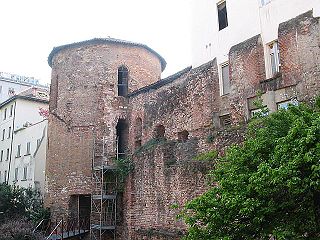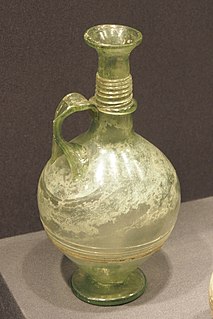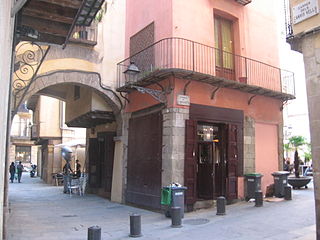
The Roman circus of Toledo is an Ancient Roman circus site of Hispania. It served the city of Toletum, the present-day Toledo, Castilla-La Mancha, Spain.

The Roman circus of Toledo is an Ancient Roman circus site of Hispania. It served the city of Toletum, the present-day Toledo, Castilla-La Mancha, Spain.
The Roman circus at Toletum (Toledo) was built in the 1st century, during the reign of emperor Augustus or emperor Tiberius. Possibly, its construction was included within the plan that the emperor undertook throughout the Roman Empire to endow all the great cities with public buildings like amphitheatres, theatres, fora , and thermae , with the aim of promoting the Romanization in these zones. In particular, the Roman circus was located in the north of the Roman city.
Given the size of the circus, as it happened in almost all Hispanic-Roman cities, it was located on the outskirts of the walled enclosure. It is certain that from the city there was a causeway to the circus, which has not been found.
Next to the circus was located another structure dedicated to leisure, the Roman theatre, just where currently the sports facilities of the college located next to the circus. The vestiges that came to the 20th century are recorded, although the use of the land for other purposes has prevented the evaluation of the remains. Checking the difference between the level of the ground between the excavated remains of the circus and the surrounding plot, it is possible that elements of the theatre are preserved below ground level, such as the stage, part of the scaenae frons and the first stands. In addition, the location of sports facilities on that site (whose need to take advantage of part of the subsoil is zero), will have allowed its conservation in an acceptable state.
A Roman amphitheatre, in the neighborhood of Covachuelas, was more distant than the circus, on the central section of Calle Honda. Not much is known of this building, since at the beginning of the 20th century the remains were dynamited to free the site for other uses.
Although little investigated, since more than half of the infrastructure still remains unexcavated, its similarities with other circuses of the Peninsula, like the one at Emerita Augusta, allow to affirm that its capacity had to be between the 15,000 or 30,000 spectators, which initially proved sufficient to meet the needs of the city as well as other surrounding towns. The Roman circus had dimensions of 422 meters long by about 112 meters wide.
With the information now available, it is not known that the Roman circus of Toletum was used for naumachia (recreation of naval battles) as it happened, for example, in the Roman circus of Tarraco.

The archaeological remains of the circus are important since it allows to affirm that, given its dimensions, its capacity and comparing it with those of other Hispanic-Roman cities of the Peninsula, Toledo must have been in Roman times a city that played an important role in the political and legal administration of the Peninsula.
The decline of the building arrived with the arrival at the Christianity that rejected this type of public events. Finally, it was with the arrival of the Visigothic domination when it ended up being abandoned. From this moment, the exspoliation of the sillars of granite that covered the opus caementicium to re-use it in other constructions. This exspoliation will extend during practically all the High Middle Ages.
During the Muslim stage, at least initially, the stands of the circus were used by merchants to locate their establishments there. Later, the Arabs used the circus as a cemetery, of which can be observed to the naked eye many vestiges. Currently, the medieval cemetery remains there, which makes the archaeological park an important medieval cemetery.
During the Late Middle Ages, it is possible that the plunder would end, although the buildings were abandoned on the outskirts of the medieval city, which made it easier for the inhabitants to bury them and the Toledans forget the location of these.
Currently there are no plans for excavation and valorization for the remains of the theatre or the amphitheatre, since it is not clear that there are remains of importance, although there is a project of enhancement of the Roman circus with the aim of completely unravelling it and make an archaeological park worthy of the Roman Toletum.

The Colosseum is an oval amphitheatre in the centre of the city of Rome, Italy, just east of the Roman Forum. It is the largest ancient amphitheatre ever built, and is still the largest standing amphitheatre in the world today, despite its age. Construction began under the emperor Vespasian in 72 and was completed in 80 AD under his successor and heir, Titus. Further modifications were made during the reign of Domitian. The three emperors that were patrons of the work are known as the Flavian dynasty, and the amphitheatre was named the Flavian Amphitheatre by later classicists and archaeologists for its association with their family name (Flavius).

Mérida is a city and municipality of Spain, part of the Province of Badajoz, and capital of the autonomous community of Extremadura. Located in the western-central part of the Iberian Peninsula at 217 metres above sea level, the city is crossed by the Guadiana and Albarregas rivers. The population was 60,119 in 2017.

Carnuntum was a Roman legionary fortress and headquarters of the Pannonian fleet from 50 AD. After the 1st century, it was capital of the Pannonia Superior province. It also became a large city of 50,000 inhabitants.

Empúries was an ancient city on the Mediterranean coast of Catalonia, Spain. Empúries is also known by its Spanish name, Ampurias. The city Ἐμπόριον was founded in 575 BC by Greek colonists from Phocaea. After the invasion of Gaul from Iberia by Hannibal the Carthaginian general in 218 BC, the city was occupied by the Romans. In the Early Middle Ages, the city's exposed coastal position left it open to marauders and it was abandoned.

Camulodunum, the Ancient Roman name for what is now Colchester in Essex, was an important city in Roman Britain, and the first capital of the province. A temporary "strapline" in the 1960s identifying it as the "oldest recorded town in Britain" has become popular with residents and is still used on heritage roadsigns on trunk road approaches. Originally the site of the Brythonic-Celtic oppidum of Camulodunon, capital of the Trinovantes and later the Catuvellauni tribes, it was first mentioned by name on coinage minted by the chieftain Tasciovanus some time between 20 and 10 BC. The Roman town began life as a Roman legionary base constructed in the AD 40s on the site of the Brythonic-Celtic fortress following its conquest by the Emperor Claudius. After the early town was destroyed during the Iceni rebellion in AD 60/61, it was rebuilt, reaching its zenith in the 2nd and 3rd centuries. During this time it was known by its official name Colonia Claudia Victricensis, often shortened to Colonia Victricensis, and as Camulodunum, a Latinised version of its original Brythonic name. The town was home to a large classical temple, two theatres, several Romano-British temples, Britain's only known chariot circus, Britain's first town walls, several large cemeteries and over 50 known mosaics and tessellated pavements. It may have reached a population of 30,000 at its height. It was not until the late 18th century that historians realised that Colchester's physical Brythonic and Roman remains were the city mentioned in ancient literature as "Camulodunum".

Mediolanum, the ancient city where Milan now stands, was originally an Insubrian city, but afterwards became an important Roman city in northern Italy. The city was settled by the Insubres around 600 BC, conquered by the Romans in 222 BC, and developed into a key centre of Western Christianity and informal capital of the Western Roman Empire. It declined under the ravages of the Gothic War, its capture by the Lombards in 569, and their decision to make Ticinum the capital of their Kingdom of Italy.

Salona was an ancient city and the capital of the Roman province of Dalmatia. Salona is located in the modern town of Solin, next to Split, in Croatia.

The Province of L'Aquila is the largest, most mountainous and least densely populated province of the Abruzzo region of Central Italy. It comprises about half the landmass of Abruzzo and occupies the western part of the region. It has borders with the provinces of Teramo to the north, Pescara and Chieti to the east, Isernia to the south and Frosinone, Rome and Rieti to the west. Its capital is the city of L'Aquila.

The Theatre of Pompey was a structure in Ancient Rome built during the latter part of the Roman Republican era by Pompey the Great. Completed in 55 BC, it was the first permanent theatre to be built in Rome. Its ruins are located at Largo di Torre Argentina.

Augusta Emerita, also called Emerita Augusta, was a Roman colonia founded in 25 BC in present day Mérida, Spain. The city was founded by Roman Emperor Augustus to resettle Emeriti soldiers from the veteran legions of the Cantabrian Wars, these being Legio V Alaudae, Legio X Gemina, and possibly Legio XX Valeria Victrix. The city was the capital of the Roman province of Lusitania, and was one of the largest in Hispania with an area of over 20,000 square kilometres (7,700 sq mi). It had three aqueducts and two fora.

Aquae Flaviae is the ancient Roman city and former bishopric of Chaves, a municipality in the Portuguese district of Vila Real.

The Roman circus was a large open-air venue used for public events in the ancient Roman Empire. The circuses were similar to the ancient Greek hippodromes, although circuses served varying purposes and differed in design and construction. Along with theatres, amphitheatres, and the similar but much smaller stadiums, circuses were one of the main entertainment sites of the time. Circuses were venues for chariot races, horse races, gladiatorial combat, and performances that commemorated important events of the Empire were performed there.

The Roman circus of Mérida is a ruined Roman circus in Mérida, Spain. Used for chariot racing, it was modelled on the Circus Maximus in Rome and other circus buildings throughout the Empire. Measuring more than 400 m in length and 30 m of width, it is one of the best preserved examples of Roman circus. It could house up to 30,000 spectators.

The Ludus Magnus was the largest of the gladiatorial schools in Rome. It was built by the emperor Domitian in the late first century C.E., alongside other building projects undertaken by him such as three other gladiatorial schools across the Roman Empire. The training school is situated directly east of the Colosseum in the valley between the Esquiline and the Caelian hills, an area already occupied by Republican and Augustan structures. While there are remains that are visible today, they belong to a reconstruction that took place under the emperor Trajan where the Ludus plane was raised by about 1.5 metres. The Ludus Magnus was essentially a gladiatorial arena where gladiators from across the Roman Empire would live, eat, and practice while undergoing gladiatorial training in preparation for fighting at the gladiatorial games held at the Colosseum.

Faversham Stone Chapel also known as Our Lady of Elwarton, is a medieval chapel built on top of a Romano-British mausoleum. The chapel is located in what is thought to have been the Roman settlement of Durolevum, near the modern town of Faversham, in Kent, England. It is the only chapel in England known to incorporate the remains of an ancient shrine or mausoleum.

Roman amphitheatres are theatres – large, circular or oval open-air venues with raised seating – built by the ancient Romans. They were used for events such as gladiator combats, venationes and executions. About 230 Roman amphitheatres have been found across the area of the Roman Empire. Early amphitheatres date from the Republican period, though they became more monumental during the Imperial era.

The Romanization of Hispania is the process by which Roman or Latin culture was introduced into the Iberian Peninsula during the period of Roman rule.

The Barcelona Roman amphitheatre is a disappeared and now invisible Roman amphitheatre in Barcelona, Catalonia, Spain. In addition, it's possible to suppose a Roman circus in another sector of the city.

The Palace of Domitian was built as Roman emperor Domitian's official residence in 81–92 AD and was used as such by subsequent emperors. Its remains sit atop and dominate the Palatine Hill in Rome, alongside other palaces.
There are remains of two Roman aqueducts which supplied the Roman city of Toletum in Castile-La Mancha, Spain. The infrastructure carried water from various sources with the main reservoir located at Mazarambroz to the south of the city in the Montes de Toledo Comarca.